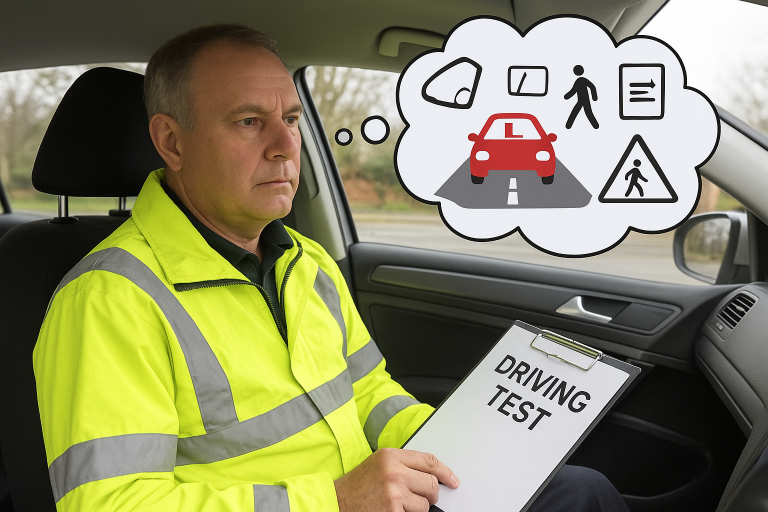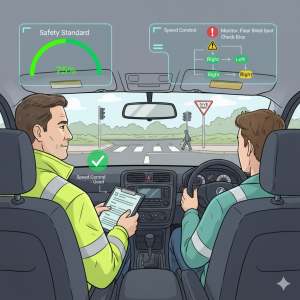
By: A DVSA Approved Driving Examiner (Perspective)
As a UK practical driving test examiner, I often see nervous candidates walk into the test centre with sweaty palms, dry mouths, and a mountain of stress sitting on their shoulders. It’s perfectly understandable — for many, the practical driving test is a major milestone. But what many candidates don’t realise is that our job isn’t to catch you out, trick you, or fail you for minor mistakes. We’re trained to be fair, consistent, and objective.
Here’s a look into how we think and what we genuinely focus on during your driving test.
1. We’re Not Trying to Fail You
Let’s get this out of the way: we don’t get a bonus for failing you. There’s no quota. We don’t enjoy seeing people upset. In fact, we’re rooting for you to pass — as long as you meet the required standard. We’re not here to test perfection; we’re here to assess safety and competence.
2. We Observe, Not Judge
Our role is to observe your driving, not judge your personality. We’re not evaluating your confidence or social skills. Whether you’re chatty or silent, young or old, our focus is your driving ability. From the moment we step into the car, we’re looking for evidence that you can drive safely, independently, and consistently.
3. We Watch for Patterns, Not One-Off Mistakes
Everyone makes small mistakes — even experienced drivers. What we look for is patterns that indicate unsafe habits. For example:
- If you miss a mirror check once, we might note it but not fail you.
- If you consistently forget mirror checks before signalling or changing direction, that suggests a dangerous habit.
The same applies to things like speed, positioning, awareness, and junction handling.
4. We Expect Nerves — and Allow for Them
We know you’re nervous. Most candidates are. A bit of hesitation at the start? That’s normal. A shaky reverse bay park? If it’s safe and under control, it’s acceptable.
We give you space to recover from nerves, and we don’t fail people just for being anxious — only if that anxiety leads to unsafe driving.
5. We Focus on Safety Above All
Our number one concern is whether you’re safe on the road. Here’s what we’re constantly assessing:
- Observation: Do you check mirrors and blind spots? Do you assess situations early and plan accordingly?
- Judgement: Do you pull out of junctions safely? Do you keep a safe following distance?
- Control: Are you in control of the vehicle — steering, braking, accelerating smoothly?
- Response to Signs and Hazards: Do you obey traffic signs and respond appropriately to developing hazards?
- Positioning and Lane Discipline: Do you stay in the correct lane and position your car correctly on different roads?
Tick those boxes, and you’re well on your way to passing.
6. We Don’t Care if You Use Sat Nav or Ask for Clarification
If you’re doing the independent driving section using a sat nav, we don’t care if you miss a turn or go the wrong way — as long as it’s done safely. And if you’re ever unsure of an instruction, you can ask us to repeat it. We don’t deduct points for asking.
7. We’re Not Interested in Style — Just Substance
Driving like a motorsport champion won’t impress us — and neither will crawling along like a snail. We’re not looking for flair; we’re looking for safe, smooth, legal driving. You don’t need to do everything perfectly, just safely and consistently.
8. Manoeuvres: We’re Looking at Technique, Not Speed
When you’re asked to do a reverse park or parallel park, we’re not timing you. Take your time, control the car, keep good observation — especially checking for pedestrians and other road users. A small correction? That’s fine. Losing all-round observation or hitting the kerb? That’s more serious.
9. A Driving Fault Isn’t the End of the World
We categorize faults into three types:
- Driving Fault (Minor): Not ideal, but not dangerous — you can make up to 15 of these.
- Serious Fault: A fault that could potentially be dangerous — often leads to a fail.
- Dangerous Fault: A real danger to you, others, or property — results in an immediate fail.
You might make a mistake and think the test is over, but unless it’s serious or dangerous, keep going! We might not mark it as a serious fault at all.
10. We Want You to Prove You Can Drive Independently
Ultimately, the test is about making sure you’re ready to be on the roads without supervision. We want to see that you can:
- Make decisions on your own
- Spot hazards early
- Adapt to changing road conditions
- Keep calm under pressure
If you can do that, we’ll be more than happy to hand you that pass certificate.
Final Thoughts from the Examiner’s Seat
We sit quietly during the test not to intimidate, but to allow you to concentrate. We don’t want to distract you, and we don’t need to talk unless necessary. When we give directions, we aim to be clear and calm. At the end of the test, whatever the result, we’ll always explain the outcome and give you feedback you can use.
Remember — we’re not your enemy. We’re just checking whether you’re safe enough to join the roads independently. Show us that, and you’ll have nothing to worry about.
Good luck — and drive safely.


